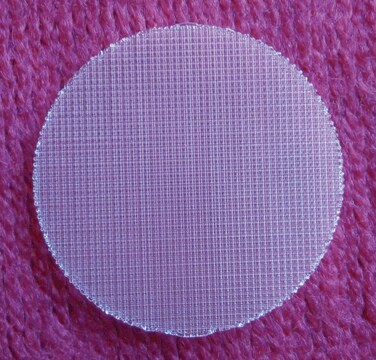This is a product of Advanced BioMatrix, Inc. This product is composed of highly purified Type I collagen.
Selecione um tamanho
Selecione um tamanho
About This Item
Produtos recomendados
fonte biológica
bovine
Nível de qualidade
esterilidade
irradiated
Diâmetro
21 mm , 5135-5EA
4 mm , 5135-25EA
espessura
1.5 mm , 5135-5EA
tamanho de poro
200 μm average pore size
Descrição geral
Outras notas
5135-5EA is 21 mm in diameter and 1.5 mm thick and fit into a 12 well culture plate or sanitary luer connectors for flow perfusion. Each package contains 5 collagen sponge discs.
Directions for Use
Preparation and Cell Seeding
Note: Cell attachment to the sponge is generally the most critical step in tissue culture. Temperature, pH, gas exchange and cell concentration can affect the rate and efficiency of attachment. Optimum seeding rate depends on the type of cell being cultured.
1. Aseptically remove the sponge discs from the packaging in a laminar flow work station.
2. Carefully place the sponges into the wells of a 12-well tissue culture plate using a sterile instrument. Be careful not to damage the sponge as it is being transferred. It is recommended to use non-treated tissue culture plasticware.
Note: Tissue-coated plasticware may need to be coated with agarose to prevent cell attachment to the plastic instead of the sponge.
3. Suspend cells at desired concentration (1x104 – 1x105 cells/mL) and dispense sufficient volume of cell solution on top of the sponge placed in the well.
Note: An alternative method is to suspend cells in a neutralized collagen solution (such as PureCol™ type I collagen Catalog #5006 or PureCol™ EZ Gel Catalog #5074). Dispense collagen/cell solution on top of the sponge placed in the well.
4. Transfer to a 37°C incubator for about 1-2 hours to allow for initial cell attachment.
Note: If using the collagen suspension method, the collagen will polymerize at 37°C and encapsulate your cells within the collagen matrix and the sponge.
5. After 1-2 hour, remove the plate from the incubator and check for cell attachment. Additional testing may be required to optimize the time it takes for the cells to attach to the sponge. Check the morphology of the cells. Cell adherence and spreading will dictate the time for attachment.
6. Once the cells have adequately attached to the sponge, increase the final volume in each well to fully cover and provide adequate medium for the culture system.
Changing the Media
1. Change the media 12-24 hours after the initial seeding. The frequency of changes will be determined by cell type, cell attachment efficiency, pH (maintain at pH 7.0 to 7.4) utilization of medium nutrients available to cultures. More frequent medium changes may be required compared to 2D culture systems.
Harvesting of Cells
Note: Protease digestion is the standard method of releasing cells from the sponges. The strength of the attachment of the cells to the collagen sponges will vary from cell line to cell line. The enzyme concentration and digestion time will vary depending upon the activity of the enzyme and the confluence of the cells. Collagenase and/or trypsin may be the preferred method.
1. Washing the sponge with EDTA-PBS may assist the protease digestion. Add sufficient volume to cover the sponge.
2. Aspirate the EDTA-PBS solution from the well.
3. Add sufficient dissociation solution to the well to fully over the sponge.
4. Transfer to a 37°C incubator. Check for cell detachment periodically for cell detachment.
5. Once the cells have fully detached, remove the cells and dispense in a centrifuge tube.
6. Centrifuge the cells as require.
Informações legais
Código de classe de armazenamento
11 - Combustible Solids
Classe de risco de água (WGK)
WGK 1
Ponto de fulgor (°F)
Not applicable
Ponto de fulgor (°C)
Not applicable
Escolha uma das versões mais recentes:
Certificados de análise (COA)
Não está vendo a versão correta?
Se precisar de uma versão específica, você pode procurar um certificado específico pelo número do lote ou da remessa.
Já possui este produto?
Encontre a documentação dos produtos que você adquiriu recentemente na biblioteca de documentos.
Os clientes também visualizaram
-
What type of collagen is specifically present on this sponge?
1 answer-
Helpful?
-
Active Filters
Nossa equipe de cientistas tem experiência em todas as áreas de pesquisa, incluindo Life Sciences, ciência de materiais, síntese química, cromatografia, química analítica e muitas outras.
Entre em contato com a assistência técnica






